Thai yellow curry chicken is a mild and slightly sweet curry known for being the creamiest among all Thai curries, with abundant use of coconut cream. This curry is characterized by its bright yellow color, which comes from using turmeric and other bright yellow spices. Unlike other Thai curries, it is not as red as made with dried chilies instead of red chilies.
This Thai yellow curry chicken recipe has two sections, one specifically showing how to prepare the Thai yellow curry paste. You can now easily make this dish at home by following this recipe, which is served in your favorite Thai restaurant.
Note: This post may contain affiliate links. Please read my privacy policy for more info. I may receive commissions for purchases made through links in this post. As an Amazon Associate, I earn from qualifying purchases.
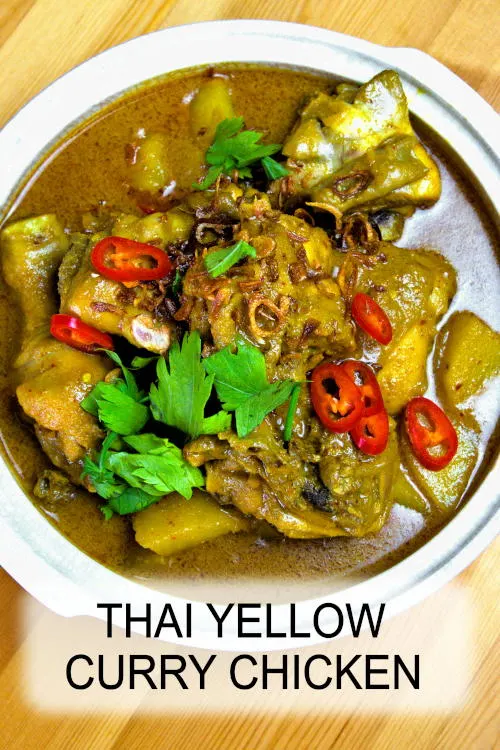
Part 1: Steps to prepare Thai yellow curry chicken
Assuming you’re using store-bought Thai yellow curry paste, here are the steps to prepare Thai yellow chicken curry. The recipe to make your own curry paste from scratch is in the later part of this article.
a. Preparation before cooking
- To prepare the Thai yellow curry chicken, first chop the chicken into roughly 1.5-inch pieces. You can use chicken breast or cut the entire chicken into pieces. I recommend using bone-in, skin-on chicken pieces to add more flavor. However, if you prefer less oil or don’t want bones in your chicken, you can use chicken breast or thigh meat and add chicken broth for extra taste while cooking.
- Cut an onion into thin strips and quarter the potatoes. You can peel the potatoes if you wish, but it is unnecessary.
- Also, prepare one to two tablespoons of tamarind juice. To prepare the juice, place a tablespoon of the tamarind pulp in hot water and let it soak for about 10 minutes. Then, let it pass through a fine strainer to get the tamarind juice. Alternatively, you can use the store-bought tamarind paste as a substitute.
b. Slow-cook the curry
- I use the traditional cooking method to saute the curry paste. First, heat some coconut cream in a pan over low heat until it becomes concentrated and changes the texture to bubblish.
- Once the coconut milk has been reduced, add the curry paste and saute until aromatic. If you don’t want to reduce the coconut cream, use olive oil to sauté the curry paste.
- Next, add the onion. If you want the onions to melt into the curry and contribute to its thickness, add them simultaneously with the curry paste. However, if you prefer to keep the onions in larger pieces, add them after the potatoes have been added. Otherwise, they may disintegrate during the cooking process.
- When the onion turns soft, add the chicken to the pot. If you want the best taste, consider marinating the chicken with light soy sauce for 15-20 minutes before adding it to the curry paste will make it more tender. You can also pan-fry the chicken pieces in a separate pan with oil over medium heat until they turn slightly brown before adding them to the curry paste in the wok. Please note that these are all optional suggestions.
- At this stage, add some water and the remaining coconut milk to the pan. You can use homemade chicken stock other than water to enhance the flavor. The amount of chicken broth and water will depend on whether you want to make the curry thinner or thicker.
- If you’re using bone-in, skin-on chicken cut into large pieces, I recommend cooking it for at least 10 minutes before adding the potatoes. This is because larger pieces of chicken take longer to cook. However, if you’re using boneless chicken meat, you can add the potatoes simultaneously with the chicken and cook them together. I recommend using waxy potatoes instead of starchy potatoes like russet because starchy potatoes can disintegrate if overcooked in a curry. Waxy potatoes can withstand longer cooking times and absorb more flavor from curry without disintegrating.
- Bring it to a boil, then reduce the heat and simmer until the potatoes are soft and tender and the chicken pieces are cooked.
Note: You can also add green beans, snap peas, snow peas, sweet potatoes, and red bell peppers to the chicken curry. Combining meat and vegetables makes this Thai dish wholesome.
c. Season the curry
- While it is simmering, season it with salt, palm sugar, and fish sauce. (Use brown sugar if palm sugar is unavailable).
- Taste-test it to check if it needs more seasoning or if the sauce needs to be thickened.
- At this point, You are likely to see the beautiful color of coconut oil floating on top. You can remove some if it is too oily.
- Add the tamarind juice to enhance the flavor in the last steps of the recipe. Be careful not to add too much, as you don’t want the dish to become too sour. Add a little bit of tanginess will make the flavor pop.
- After the curry is cooked, transfer it to a serving container and garnish with fried shallots, red chilies, Thai basil, and coriander leaves. Drizzle some lime juice to accentuate the taste if you like. This dish is best enjoyed with white rice/Jasmine rice.
Note:
- If using freshly pressed coconut cream, you will notice the coconut oil separating from the coconut cream after some time. However, this may not happen if using store-bought coconut cream that has already been homogenized with a stabilizer. However, it doesn’t matter if separation does not occur. Separation of the oil is unimportant, but it will result in a visually appealing yellow oil floating on top of the curry when served.
- For more authentic curry, use palm sugar. Brown or regular sugar can be substituted.
- You can use a pressure cooker (Instant Pot) or prepare it on a stovetop. Please use less water when using a multi-cooker compared to when cooking it on a stovetop.
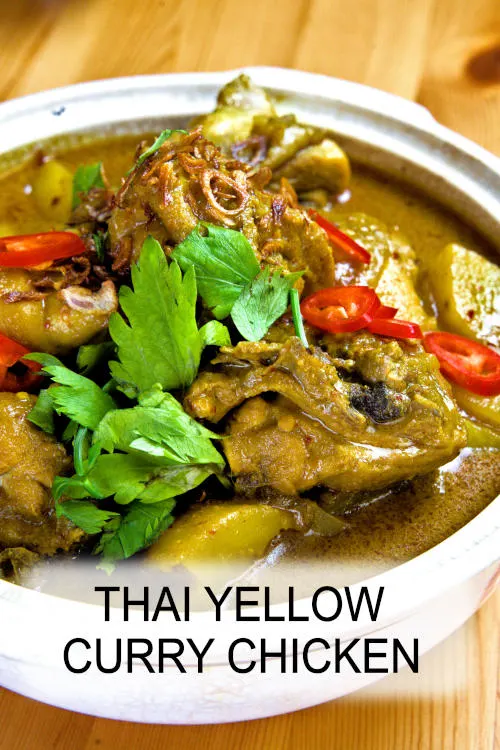
Part 2: How to make the Thai yellow curry paste from scratch
I must confess that I often use yellow curry paste purchased from Asian stores. But sometimes, I challenge myself and experiment with different flavors I can’t get from the standard store-bought paste. That’s when I decided to make my own.
If you’re like me and enjoy making everything from scratch, here’s my Thai yellow curry paste recipe. It’s relatively easy to make, but it might not be worthwhile if you only need a small amount. Plus, you’ll need to have all the ingredients on hand. If you’re up for it and don’t mind spending extra time, try it!
Below are the steps to prepare the Thai curry paste from scratch
a. Ingredients
To make the Thai Yellow Curry paste, you will need the following ingredients:
- Dry red chilies: These are commonly found in Asia, but you can get them from most Asian grocery stores if you don’t live in Asia. If you prefer a lower spice level, remove the seeds before adding them to the blender.
- Coriander and cumin seeds: Using the seeds instead of the ground spices will give the paste a fresher and better taste.
- White peppercorns: Using whole peppercorns instead of ground pepper will make the paste more flavorful.
- Curry powder: Any curry powder will do, but if you want to keep it authentic, you can use Indian or the Baba brand of curry powder made in Malaysia.
- Lemongrass: Cut away both ends of the lemongrass, then peel off the outer sheath, and use only the bulb, which is more tender. Bash the bulb with a knife and cut it into thin slices to make blending easier.
- Fresh ginger, galangal, and fresh turmeric: Chop these ingredients into fine pieces. Note that galangal may not be available in certain places. Your local grocery stores selling Asian food products are the best bet.
- Garlic: Finely chop a few cloves of garlic.
- Fermented Thai shrimp paste: This adds a unique flavor and is similar to another type of shrimp paste from Malaysia called Belacan.
b. Method:
- Cut the lemongrass, galangal, ginger, and turmeric into small pieces.
- Wash the dried chilies and cut them into short sections.
- Then, grind all the dried spices separately in a coffee or spice grinder.
- Blend all the ingredients in a blender with enough oil until smooth.
Keep the yellow curry paste in an airtight container in the freezer for several months or in the refrigerator for a few weeks.
Coconut cream or milk
If you cannot get fresh coconut cream, you can use canned coconut milk as an alternative. However, the terms coconut cream and coconut milk can be confusing. Some coconut milk is diluted with additives and meant for drinking, not cooking. When purchasing coconut cream for cooking, ensure it is undiluted, full-fat coconut milk (cream). In addition, when checking the cream’s suitability, ensure it has a fat content of around 20 to 25%.
Related Thai cuisines to this Thai yellow curry recipe
If you enjoy Thai food, we have some delicious recommendations for you! Here are some handpicked Thai recipes from this food blog:
- Massaman curry is a Thai curry of Persian origin that is mild but rich in flavor. It has been adapted into the classic Thai cuisine in the Southern region of Thailand.
- If you like something spicer, try the Thai red curry. You can use the pre-made curry paste to save time.
- Thai Basil Chicken is a flavorful one-pot meal that is quick and easy to prepare. It’s great to serve over steamed rice with a fried egg on top.
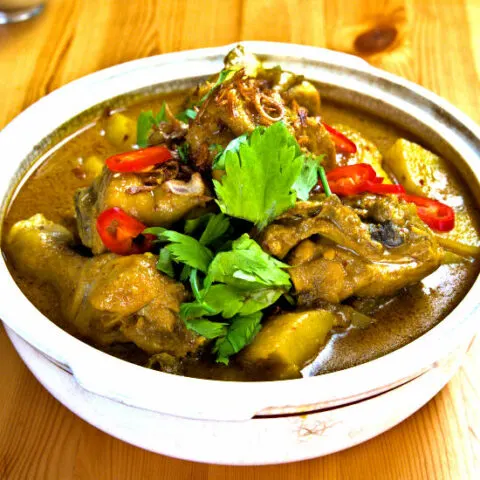
Thai yellow curry chicken
This Thai yellow curry recipe can be done from scratch or by using the pre-made curry paste. Simple delicious.
Ingredients
Ingredients (main)
- 1kg chicken meat of your choice
- 300g potatoes
- 1 medium size onion
- 1 cup coconut cream
- 120g Thai yellow curry paste
- 2 tbsp palm sugar
- 2 tbsp fish sauce
- 2 tbsp tamarind juice
Ingredients (garnish)
- Coriander leaves
- Fried shallots
- Red chili slices
Instructions
- Prepare two tablespoons of tamarind juice by placing a tablespoon of the tamarind pulp in hot water and letting it soak for about 10 minutes. Then, let it pass through a fine strainer to get the tamarind juice.
- Heat some coconut cream in a pan over low heat until it becomes concentrated and changes the texture to bubblish.
- Add the curry paste and saute until aromatic.
- Next, add the onion. When the onion turns soft, add the chicken to the pot.
- Add some water and the remaining coconut milk to the pan. The amount of water will depend on whether you want to make the curry thinner or thicker.
- Cook for 10 minutes, then add the potatoes.
- Reduce the heat and simmer until the potatoes are soft and tender and the chicken pieces are cooked.
- Season it with salt, palm sugar, and fish sauce.
- Add the tamarind juice to enhance the flavor.
- Garnish with fried shallots, red chilies, and coriander leaves.
Notes
If you want to make your own curry paste, here are the ingredients and instructions.
Ingredients for Thai curry paste
- 5 tbsp oil
- 10 dried chilies
- 1 tbsp coriander seeds
- 1 tsp cumin seeds
- 1/4 tsp white peppercorns
- 1 tbsp Baba curry powder
- 1 stalks lemongrass
- 2 tbsp chopped ginger
- 2 tbsp chopped galangal
- 1 tsp turmeric powder
- 6 cloves of garlic
- 1 tbsp Thai shrimp paste
Method
Please refer to the section titled "How to Make Thai Yellow Curry Paste from Scratch" above.
Recommended Products
As an Amazon Associate and member of other affiliate programs, I earn from qualifying purchases.
Nutrition Information:
Yield: 3 Serving Size: 1Amount Per Serving: Calories: 1196Total Fat: 42gSaturated Fat: 22gTrans Fat: 0gUnsaturated Fat: 16gCholesterol: 297mgSodium: 3734mgCarbohydrates: 99gFiber: 4gSugar: 66gProtein: 103g
This data was provided and calculated by Nutritionix on 11/08/2023

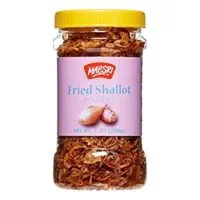
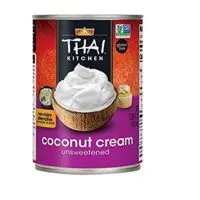


Green Curry with Chicken | Eight-ingredient Easy Thai Recipe
Thursday 15th of August 2024
[…] Yellow Curry: It is another type of Thai curry that is slightly spicier than green curry. […]
Ken
Saturday 11th of November 2023
Your recipes are too complex and require many ingredients that are too difficult to find
KP Kwan
Sunday 12th of November 2023
Understand. Please use the store-bought yellow curry paste to make it simple.
KP Kwan
Thursday 9th of November 2023
Hi, this is KP Kwan. Thank you for reading my recipe. Please feel free to ask any questions or leave comments. I'll respond as soon as possible.